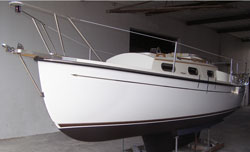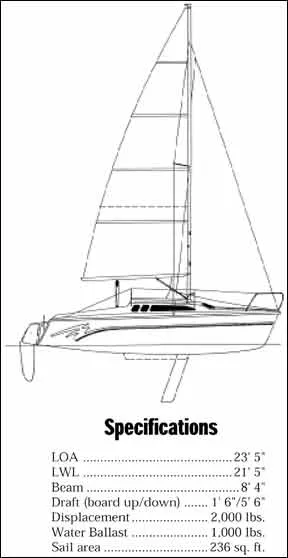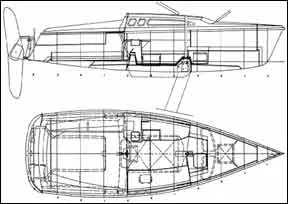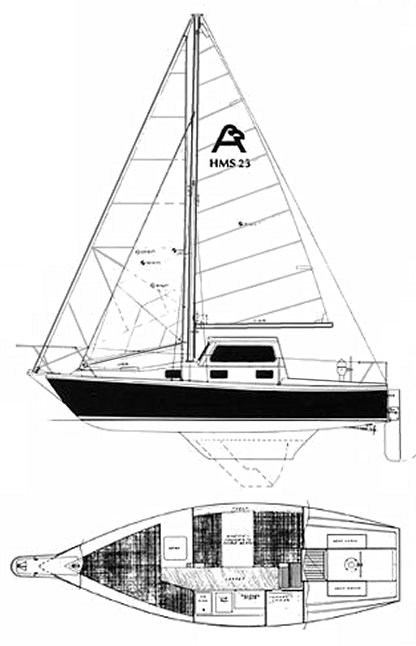- Com-Pac Yachts Home
- Sun Cat Daysailer
- Horizon Cat
- Horizon Day Cat
- Com-Pac Legacy
- Com-Pac Legacy Sport
- Com-Pac Eclipse
- CP 23 Pilothouse
- Com-Pac 23/IV
- Com-Pac 27/3

The Com-Pac 23/IV
When sailing, the com-pac 23/iv is in her element.

- See video of the Com-Pac 23/IV
- See our Photo Gallery of the Com-Pac 23/IV
The venerable Com-Pac 23 is now in its 4th evolution. The 23/IV includes upgrades such as:
- All stainless steel hardware, ports and mooring cleats
- Rigid PVC rubrail with stainless steel striker plate
- Foil rudder blade with control handle
- Interior modifications that allow for easier installation of instruments, radios, and shore power
The Com-Pac 23/IV offers accommodations and equipment which make her a most exceptional yacht.
With a two-cabin layout for privacy, a standard-equipment, hide-a-way galley and shoal-draft keel developed from NACA low-drag, high-lift wing sections, the Com-Pac 23/IV is ready for extended cruising and gunkholing.
Standard Equipment
Hull and Deck
- ISO/NPT gel coat finish
- Hand laminated fiberglass construction
- Molded in contrasting non-skid surface
- Shoal draft keel with fiberglass centerboard
- Internal fixed lead ballast
- Recessed anchor locker on deck
- Molded toe rails w/drains
- Aluminum frame opening forward hatch4-6" mooring cleats
- Stainless steel bow pulpit
- Stainless steel stern rail, stanchions & lifelines
- Stainless steel boarding ladder
- Stainless steel bow eye
- Accent waterline & sheer stripes
- Teak handrails
- 7'0" self bailing cockpit
- Ventilated fuel tank locker
- Sail locker
- Laminated ash and mahogany tiller
- Stainless steel adjustable motor mount
- Welded aluminum rudder head
- Molded 'structural grid' hull liner
- Deluxe fabric covered cushions
- Berths for 4 adults
- Backrest cushions w/shelves
- Shelves over v-berths
- Molded storage lockers under berths
- 12 volt electrical system
- Fused switch panel
- Interior lights
- Navigation lights
- Steaming light
Spars and Rigging
- Aluminum anodized mast & boom
- 4:1 Harken mainsheet system
- Harken genoa winches & handle
- Harken ball bearing blocks
- Genoa track with cars
- Pre-stretched Dacron halyards
- Spliced halyard shackles
- Pre-stretched Dacron sheets & running rigging
- Split backstayChromed bronze open body turnbuckles w/toggles
- Topping lift
- Hinged mast step
- Alcohol stove
- Stainless steel sink
- Manual water pump
- Storage bins
- Self contained water system
- Dacron main and jib
- Jiffy reefing system with 1 reef point
- New Sailboats
- Sailboats 21-30ft
- Sailboats 31-35ft
- Sailboats 36-40ft
- Sailboats Over 40ft
- Sailboats Under 21feet
- used_sailboats
- Apps and Computer Programs
- Communications
- Fishfinders
- Handheld Electronics
- Plotters MFDS Rradar
- Wind, Speed & Depth Instruments
- Anchoring Mooring
- Running Rigging
- Sails Canvas
- Standing Rigging
- Diesel Engines
- Off Grid Energy
- Cleaning Waxing
- DIY Projects
- Repair, Tools & Materials
- Spare Parts
- Tools & Gadgets
- Cabin Comfort
- Ventilation
- Footwear Apparel
- Foul Weather Gear
- Mailport & PS Advisor
- Inside Practical Sailor Blog
- Activate My Web Access
- Reset Password
- Pay My Bill
- Customer Service

- Free Newsletter
- Give a Gift

How to Sell Your Boat

Cal 2-46: A Venerable Lapworth Design Brought Up to Date

Rhumb Lines: Show Highlights from Annapolis

Open Transom Pros and Cons

Leaping Into Lithium

The Importance of Sea State in Weather Planning

Do-it-yourself Electrical System Survey and Inspection

Install a Standalone Sounder Without Drilling

When Should We Retire Dyneema Stays and Running Rigging?

Rethinking MOB Prevention

Top-notch Wind Indicators

The Everlasting Multihull Trampoline

How Dangerous is Your Shore Power?

DIY survey of boat solar and wind turbine systems

What’s Involved in Setting Up a Lithium Battery System?

The Scraper-only Approach to Bottom Paint Removal

Can You Recoat Dyneema?

Gonytia Hot Knife Proves its Mettle

Where Winches Dare to Go

The Day Sailor’s First-Aid Kit

Choosing and Securing Seat Cushions

Cockpit Drains on Race Boats

Rhumb Lines: Livin’ the Wharf Rat Life

Re-sealing the Seams on Waterproof Fabrics


Safer Sailing: Add Leg Loops to Your Harness

Waxing and Polishing Your Boat

Reducing Engine Room Noise

Tricks and Tips to Forming Do-it-yourself Rigging Terminals

Marine Toilet Maintenance Tips

Learning to Live with Plastic Boat Bits
- Sailboat Reviews
Hunter 23.5
This family cruiser is innovative and has lots of room. in gusty winds, however, it is quick to stall..
Hunter Marine Corp. is noted for its slick, innovative and low-cost mass production sailers. The Hunter 23.5, new in 1992, fits the bill in all respects.

The 23.5 was designed as a trailerable family cruiser for entry-level sailors. Like most Hunters, the boat offers lots of space in the cockpit and down below, and comes with the famous Cruise Pac, which provides just about anything a customer needs, including sails, motor, trailer, lifelines, anchor, life jackets, flares and a copy of Chapman’s Piloting, Seamanship and Small Boat Handling . It’s this type of marketing (plus price: the 1992 price was $13,500) that has helped make Hunter one of the most successful sailboat producers in the U.S.
No one has ever faulted the Alachua, Florida, builder for offering anything but fresh, well-thought out designs. The most striking feature of the 23.5 is its water ballast system, new to Hunter. The system permits an operator to remove 1,000 pounds of ballast from the trailering weight. A retractable centerboard, kick-up rudder and mast that’s fairly easy to step and unstep further enhances trailerability. All told, boat, motor and trailer weigh a combined 2,450 pounds. This model also contains enough foam to provide positive flotation.
While Hunter has enjoyed considerable success with the buying public, it has also suffered from a negative image problem. Earlier PS reviews have criticized Hunter products for a lack of quality control-various systems kinks, lightweight hulls, poor finish work and general absence of blue-water seaworthiness. On the other hand, Hunter owners, while acknowledging a prevailing lack of respect, frequently defend their choice. In the realm of objective data, Coast Guard complaint and recall statistics reveal that Hunter has a better than average record when it comes to hull blistering. (Hunter offers five-year bottom blister warranty protection for the 23.5.) Clearly, the company is doing something right. The model we inspected (hull #8) showed, with very few exceptions, careful attention to detail and finish work in even the least accessible places-more than youd expect on a $13,500 boat. But it is also a boat with some inherent contradictions, in our opinion.
The 23.5 is a highly engineered product with lots of thoughtful features. Hunter, unlike some builders, constructs a mock-up, followed by a prototype that is extensively tested before final design decisions are made. The hull form is modern looking, almost powerboaty in appearance from some angles. Continuing a tendency evident in recent Hunters, the design team has given the 23.5 a relatively full hull, and raised the freeboard to reduce the cabin height, as well as add room below and keep those up top dry in a chop. Because the cabin extends to the rail (no side decks), you must climb over the cabin top to get to the foredeck.
The rig (a B&R design) consists of a 28-foot Z. Spar mast, fractionally rigged with swept-back spreaders that eliminate the need for a backstay (and make un-stepping/stepping, hence trailering, simpler); for the most part, the uppers are aft of the “after” lowers-until deck level-creating a triangular support system. Main and jib halyards are internal and led back to the cockpit. Power comes from a fully battenedmainsail and 110-percent jib (UK Sailmakers-Hong Kong) with a total of 236 square feet. For steering, the traditional wooden tiller has been replaced with a brushed aluminum tube that arches over the walk-through transom (swim ladder comes standard). The aluminum, said chief designer Rob Mazza, weathers better and is easier to arch in order to keep the rudder low and the tiller sufficiently high. Many helmsmen will use the standard Ronstan X-10 tiller extension.
The water ballast/keel system constitutes the key feature of the 23.5. The water ballast-125 gallons, or 1,000 pounds-takes about two minutes to bring on board. The system is activated by flipping up a lid at the base of the companionway, opening a vent and turning a T-valve; the valve in turn drops a circular stainless steel plate aft of the keel, exposing four holes in the hull. (The plate can then be closed flush.) And while you can’t jettison the water downwind, you can swing up the centerboard to reduce draft to 18 inches. The 4-foot centerboard, controlled by the outboard line to the cockpit, moves easily up and down via a cascade block and tackle arrangement.
The apparent thinking of Hunter engineers was to provide a simple, one-step water ballast system that keeps draft shallow while lowering the center of gravity for added stability and righting moment. The ballast-about 16 cubic feet in volume-lies immediately below the waterline. When the water is added, the boat sinks several inches. Nevertheless, while the water adds 1,000 pounds to the overall displacement, its location does not seem to provide sufficient righting moment for windward work in gusty conditions. On racing boats, water ballast is carried above the waterline and outboard under the settees, which of course provides more righting moment. But this water must be pumped into the chambers and drained before tacking-too complicated for Hunter’s purposes.

Construction of the boat is fairly straightforward, with balsa in the hull and plywood in the deck. The plywood core has the potential to encourage water migration should a deck leak occur at some point. The deck/hull joint, with a roll similar to a Hobie 18-a “modified shoebox,” one Hunter engineer described it-is bonded with glass and further fastened by flathead screws through the rubrail. Stanchions, fastened to aluminum backing plates that are glassed in, are sturdy. Though not a heavily-built boat, the 23 looks solid enough; in the absence of a graceful hull form-no sheer here-Hunter provides some added dash with a smoked forward-facing window and a green and purple hull swoosh graphic, which apparently has drawn strong reaction, pro and con (We liked it). Oddly, there is no waterline or boot scribed in the hull. Perhaps Hunter anticipates owners dry-sailing the 23.5, but the absence of a waterline mark will make bottom painting a difficult chore the first time.
Performance
We test sailed the 23.5 off Newport, Rhode Island. In light-air conditions, the shallow-body, lightweight boat (displacement 3,000 pounds with the water ballast) moved up to speed quickly. The boat pointed high and the few light puffs we experienced produced no noticeable helm. We did have some problem finding a definitive groove, especially after tacking. The boat glided through the water easily on a reach and downwind, with the board up, sped along as much as a 23-footer can (Mazza said it will surf under the right conditions). We moved relatively faster, in fact, than a Nonsuch 27 on the same tack.
In stronger 15-20 knot winds, it is a whole different experience. With a single reef in the mainsail, the boat consistently rounds up and stalls. In addition to the boat’s higher vertical center of gravity, this tendency may also be due to the very high-aspect ratio centerboard, which is generally associated with quick stall characteristics.
Complicating matters is the way the rig and sheeting are set up. With no backstay (or topping lift) and no traveler, and with the main sheeted down and far forward near the companionway, the main and sheet are highly stressed. And because the cam cleat for the mainsheet is down near the cockpit sole, it’s difficult to reach-especially in heavy air on a beat, when the helmsman and everyone else is out on the rail. The rounding up and stalling require constant spilling of the main. This may be okay (if tiring) for the experienced sailor, but a bit strenuous and nerve-wracking for the beginner at whom this boat is marketed.
Instead of a single reef, one solution might be to take a second reef in the main in anything approaching 15 knots, but that’s not much of a solution. With 236 square feet of sail-128 in the main, 108 in the foretriangle-for a sail area-displacement ratio of 18.9, the boat should not be overpowered. (The O’Day 23, of about the same displacement, but with 200 more pounds of ballast, carries 246 square feet)
Another solution, although it breaks up the cockpit, might be a barney post where there’s already a slot for the cockpit table, a system that worked well enough in the Alerion-Express. A traveler would be even better, though obviously Hunter wanted to keep the cockpit clear of obstructions as well as avoid the added cost.
Accommodations
You get a lot for your money with this Hunter model. One thing you get a lot of is interior space or, as company literature describes it, “a 25-foot boat in a 23.5 hull.” The main cabin is sizable and has more headroom than we’ve seen on a 23-footer. A pop-top hatch allows those down below to stand up in the center of the cabin. An optional canvas camper top ($300) provides protection from the elements. Poptops are notoriously leaky, and we can’t vouch for this one’s water tightness; however, Hunter has provided drains all around.
The smoked pop-top, plus three ports per side in the main cabin (two small circles, one longer swoosh-style forward) and the forward-facing window provide plenty of light. Hunter has made no attempt to yacht-up the interior: What you get is a basic cream-colored liner, offset on a portion of the topsides by a close-weave grayish fabric someone called “monkey fur.” Despite the plainness, we liked the clean look of the interior.
Aft to port in the main cabin you get a galley station with a one-burner alcohol stove, sink, and fold-out table with storage below. You won’t be whipping up any Cruising World -style feasts in this galley, but it’s nice to be able to heat up some coffee or a cup of soup. Forward of the galley is a small settee/berth, sized right for a child, with storage beneath and a cutout for a portable ice chest. Opposite is a somewhat longer settee/berth of less than six feet, with more storage and a battery compartment below. On the centerline is a slot for a small table that also can be set up in the cockpit.
There are a number of helpful additions: an automatic bilge pump, access plates underneath the cockpit winches. The portable toilet is located to starboard behind a half-bulkhead and privacy curtain, and under the V-berth. Aside from the standard V-berth in the bow, which seems a bit cramped, there’s a double berth (plus stowage) aft of the main cabin, under the cockpit and seats (not for the claustrophobic). It was back here in the bowels of the boat that we spotted the only untrimmed fiberglass.
On deck, there’s an equally roomy cockpit-7′ 9″ long and 6′ 2″ from coaming to coaming. The relatively wide beam makes the addition of a ridge along the centerline for use as a footrest a welcome touch. Foam padding on the seatbacks is another. A lazaret on either side provides on-deck stowage. There’s a #8 Barient winch on either side of the cabin top, each with an attendant cleat. Lines are meant to be kept in the no-name stoppers to starboard. Because of the profusion of lines led back on the starboard side, we’d prefer an extra cleat and winch.
Nonskid is molded in. The foredeck holds an anchor locker, which also contains a padeye for the stepping/unstepping operation. Skipping the details of this procedure-which involves use of a gin pole, the main and jib halyards and a bridle that controls lateral movement-we’d say that Hunter has devised as easy a way to drop a mast as is possible. Once down, the forward end rests in a U-shaped bend in the bow pulpit, the aft end on a roller-topped pole fitted at the transom.
Conclusions
In its attempt to create a simply operated, easily trailered, entry-level boat at a good price, Hunter has come up with some clever compromises. But they are compromises just the same. The 23.5 sails well on all points in light air; it does well off the wind in heavier air. Windward work over 15 knots in this boat is poor in our estimation. We’d strongly recommend that potential customers thoroughly test sail the boat in a variety of wind conditions, experimenting with one or two reefs, to be certain it’s something they’re able-and willing-to handle.
The Hunter 23.5 is clearly striking a chord with some buyers, and assuming many are entry-level sailors, we think it’s great that this boat is attracting newcomers to the sport. The design represents a clever way of managing the trailering problem (i.e., weight and draft). At the same time, we can’t help but wonder if its behavior in gusty winds is worth the convenience of dumping ballast on the launch ramp.
RELATED ARTICLES MORE FROM AUTHOR
excellent article.
Darrell – excellent review. Thanks.
Thanks for the review, I just saw one for sale online.
LEAVE A REPLY Cancel reply
Log in to leave a comment
Latest Videos

Bahamas Travel Advisory: Cause for Concern?

Island Packet 370: What You Should Know | Boat Review

How To Make Starlink Better On Your Boat | Interview

Catalina 380: What You Should Know | Boat Review
- Privacy Policy
- Do Not Sell My Personal Information
- Online Account Activation
- Privacy Manager
Allmand 23 hms 23
The allmand 23 hms 23 is a 23.0ft cutter built in fiberglass by allmand boats inc.(usa) since 1975..
The Allmand 23 hms 23 is a light sailboat which is slightly under powered. It is very stable / stiff and has a low righting capability if capsized. It is best suited as a day-boat.

Allmand 23 hms 23 for sale elsewhere on the web:

Main features
Login or register to personnalize this screen.
You will be able to pin external links of your choice.

See how Sailboatlab works in video

We help you build your own hydraulic steering system - Lecomble & Schmitt
Accommodations
Builder data, modal title.
The content of your modal.
Personalize your sailboat data sheet
Great choice! Your favorites are temporarily saved for this session. Sign in to save them permanently, access them on any device, and receive relevant alerts.
- Sailboat Guide
Allmand 23 (Hms 23)
Allmand 23 (Hms 23) is a 22 ′ 11 ″ / 7 m monohull sailboat built by Allmand Boats Inc.(USA) starting in 1975.

Rig and Sails
Auxilary power, accomodations, calculations.
The theoretical maximum speed that a displacement hull can move efficiently through the water is determined by it's waterline length and displacement. It may be unable to reach this speed if the boat is underpowered or heavily loaded, though it may exceed this speed given enough power. Read more.
Classic hull speed formula:
Hull Speed = 1.34 x √LWL
Max Speed/Length ratio = 8.26 ÷ Displacement/Length ratio .311 Hull Speed = Max Speed/Length ratio x √LWL
Sail Area / Displacement Ratio
A measure of the power of the sails relative to the weight of the boat. The higher the number, the higher the performance, but the harder the boat will be to handle. This ratio is a "non-dimensional" value that facilitates comparisons between boats of different types and sizes. Read more.
SA/D = SA ÷ (D ÷ 64) 2/3
- SA : Sail area in square feet, derived by adding the mainsail area to 100% of the foretriangle area (the lateral area above the deck between the mast and the forestay).
- D : Displacement in pounds.
Ballast / Displacement Ratio
A measure of the stability of a boat's hull that suggests how well a monohull will stand up to its sails. The ballast displacement ratio indicates how much of the weight of a boat is placed for maximum stability against capsizing and is an indicator of stiffness and resistance to capsize.
Ballast / Displacement * 100
Displacement / Length Ratio
A measure of the weight of the boat relative to it's length at the waterline. The higher a boat’s D/L ratio, the more easily it will carry a load and the more comfortable its motion will be. The lower a boat's ratio is, the less power it takes to drive the boat to its nominal hull speed or beyond. Read more.
D/L = (D ÷ 2240) ÷ (0.01 x LWL)³
- D: Displacement of the boat in pounds.
- LWL: Waterline length in feet
Comfort Ratio
This ratio assess how quickly and abruptly a boat’s hull reacts to waves in a significant seaway, these being the elements of a boat’s motion most likely to cause seasickness. Read more.
Comfort ratio = D ÷ (.65 x (.7 LWL + .3 LOA) x Beam 1.33 )
- D: Displacement of the boat in pounds
- LOA: Length overall in feet
- Beam: Width of boat at the widest point in feet
Capsize Screening Formula
This formula attempts to indicate whether a given boat might be too wide and light to readily right itself after being overturned in extreme conditions. Read more.
CSV = Beam ÷ ³√(D / 64)
Also called HMS 23. Available with fixed or swing keel. Inboard power available as an option. Built in very small numbers. Dimensions from builders literature.
Embed this page on your own website by copying and pasting this code.
- About Sailboat Guide
©2024 Sea Time Tech, LLC
This site is protected by reCAPTCHA and the Google Privacy Policy and Terms of Service apply.

IMAGES
VIDEO
COMMENTS
40 to 50 indicates a heavy bluewater boat; over 50 indicates an extremely heavy bluewater boat. Comfort ratio = D ÷ (.65 x (.7 LWL + .3 LOA) x Beam^1.33), where displacement is expressed in pounds, and length is expressed in feet. Capsize Screening Formula (CSF): Designed to determine if a boat has blue water capability.
1195 Kapp Dr., Clearwater, Florida 33765 USA. Call Us: 727-443-4408. E-mail Us: [email protected]. The Com-Pac 23/IV offers accommodations and equipment which make her a most exceptional yacht.
40 to 50 indicates a heavy bluewater boat; over 50 indicates an extremely heavy bluewater boat. Comfort ratio = D ÷ (.65 x (.7 LWL + .3 LOA) x Beam^1.33), where displacement is expressed in pounds, and length is expressed in feet. Capsize Screening Formula (CSF): Designed to determine if a boat has blue water capability.
Com-Pac 23 is a 22′ 8″ / 6.9 m monohull sailboat designed by Clark Mills and built by Com-Pac Yachts starting in 1978. Great choice! Your favorites are temporarily saved for this session. ... The lower a boat's ratio is, the less power it takes to drive the boat to its nominal hull speed or beyond. Read more. Formula. D/L = (D ÷ 2240) ÷ ...
Hunter 23 is a 23′ 3″ / 7.1 m monohull sailboat designed by Hunter Marine and built by Hunter Marine between 1985 and 1992. Great choice! Your favorites are temporarily saved for this session. ... The lower a boat's ratio is, the less power it takes to drive the boat to its nominal hull speed or beyond. Read more. Formula. D/L = (D ÷ 2240 ...
DRAFT, Board down - 5' 4". Displacement - 2,450 lbs. Ballast - 850 lbs. (Internal fixed lead) Sail area - 248 sq. ft. Mast height above DWL - 35' 4". Designer: -- Jim Taylor. Design Comments. Considered to be a "maxi-trailerable", the Precision 23 far outstrips many boats in terms of true usable space, both on deck and below. Special emphasis ...
The R-23 had an excellent production run, with 739 hulls built between 1971 and 1978. The boat is a sporty looker whose design is as appealing 30 years after her launch as when introduced. She carries a high-aspect sailplan and presents a fine bow entry and racy lines, especially compared to her contemporaries.
Price: $20,240 (sailaway, FOB Palmetto, FL). Precision Boat Works, tel. 941-722-6601. Not all pocket cruisers are water-ballasted. The Jim Taylor-designed Precision 23 achieves stability with fixed ballast and a shallow keel/centerboard configuration. With the board up the minimum draft is just under 2 feet; draft increases to 5 feet, 4 inches ...
The Precision 23 is a small recreational keelboat, built predominantly of fiberglass, with teak wood trim. It has a fractional sloop rig, a transom-hung rudder and a fixed stub keel with a retractable centerboard that is raised and lowered by a Dacron line, plus a "kick-up" rudder. It displaces 2,450 lb (1,111 kg) and carries 850 lb (386 kg) of ...
Besides the 1' bowprit, the SOVEREIGN 23, & 24 appear similar other than an inboard engine offered for the 24. A version with a deeper keel (3.67') was also advertised. SOVEREIGN 23,24,and 7M all share the same hull but with different decks, interior layouts, options etc. It is thought they all come from the same hull mold as the S2 7.0.
217.76 sq ft (20.231 m 2) Racing. PHRF. 282. [ edit on Wikidata] The Aquarius 23 is an American trailerable sailboat that was designed by Peter Barrett and Stan Miller as a cruiser and first built in 1969. [1] [2] [3] The design was developed into several derivative models, the Aquarius 23-2, the Aquarius 7.0 and the Balboa 23.
Hunter 23.5 Specs. The 23.5 was designed as a trailerable family cruiser for entry-level sailors. Like most Hunters, the boat offers lots of space in the cockpit and down below, and comes with the famous Cruise Pac, which provides just about anything a customer needs, including sails, motor, trailer, lifelines, anchor, life jackets, flares and a copy of Chapman's Piloting, Seamanship and ...
The Hunter 23 is a 23.25ft fractional sloop designed by Hunter Marine and built in fiberglass by Hunter Marine (USA) between 1985 and 1992. The Hunter 23 is a light sailboat which is a high performer. It is reasonably stable / stiff and has a low righting capability if capsized. It is best suited as a racing boat. Hunter 23 for sale elsewhere ...
Design[edit] The Hunter 23 is a small recreational keelboat, built predominantly of fiberglass, with wood trim. It has a fractional sloop rig, a raked stem, a reverse transom, a transom-hung rudder controlled by a tiller and a fixed wing keel or centerboard. It displaces 2,450 lb (1,111 kg) and carries 800 lb (363 kg) of ballast.
The Precision 23 is a 23.42ft fractional sloop designed by Jim Taylor and built in fiberglass by Precision Boat Works since 1986. 500 units have been built. The Precision 23 is a light sailboat which is a high performer. It is stable / stiff and has a low righting capability if capsized. It is best suited as a racing boat.
The North american 23 is a 23.0ft masthead sloop designed by Robert Finch and built in fiberglass by Glastron (USA) between 1976 and 1978. The North american 23 is a light sailboat which is a reasonably good performer. It is reasonably stable / stiff and has a low righting capability if capsized. It is best suited as a day-boat.
The Seaward 23 is a recreational keelboat, built predominantly of solid fiberglass, with wood trim. It has a fractional sloop rig, a plumb stem with a bowsprit, a vertical transom, a transom-hung rudder controlled by a tiller or optional wheel and a fixed wing keel. The cabin has rectangular ports. A free-standing catboat rig, with a carbon ...
The Allmand 23 hms 23 is a 23.0ft cutter built in fiberglass by Allmand Boats Inc. (USA) since 1975. The Allmand 23 hms 23 is a light sailboat which is slightly under powered. It is very stable / stiff and has a low righting capability if capsized. It is best suited as a day-boat.
Notes. Same hull as the 23. Changes from the Mk2 include some tooling upgrades like converting round port lights to oval. At about this time, the builder began offering an optional 9 hp Yanmar inboard diesel engine. About 35 boats with the inboard were produced.
Allmand 23 (Hms 23) is a 22′ 11″ / 7 m monohull sailboat built by Allmand Boats Inc.(USA) starting in 1975. Great choice! Your favorites are temporarily saved for this session. ... The lower a boat's ratio is, the less power it takes to drive the boat to its nominal hull speed or beyond. Read more. Formula. D/L = (D ÷ 2240) ÷ (0.01 x LWL)³
40 to 50 indicates a heavy bluewater boat; over 50 indicates an extremely heavy bluewater boat. Comfort ratio = D ÷ (.65 x (.7 LWL + .3 LOA) x Beam^1.33), where displacement is expressed in pounds, and length is expressed in feet. Capsize Screening Formula (CSF): Designed to determine if a boat has blue water capability.
40 to 50 indicates a heavy bluewater boat; over 50 indicates an extremely heavy bluewater boat. Comfort ratio = D ÷ (.65 x (.7 LWL + .3 LOA) x Beam^1.33), where displacement is expressed in pounds, and length is expressed in feet. Capsize Screening Formula (CSF): Designed to determine if a boat has blue water capability.
Sailboat Specifications Definitions Hull Type: Fin w/spade rudder: Rigging Type: Fractional Sloop: LOA: 23.00 ft / 7.01 m: LWL: 19.92 ft / 6.07 m: S.A. (reported): ... to the bottom of the keel or fin. Like the LWL, it will vary with the weights of fuel, water, stores and equipment. A boat's actual draft is usually somewhat more than the ...